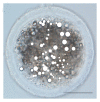A role of lipid metabolism during cumulus-oocyte complex maturation: impact of lipid modulators to improve embryo production
- PMID: 24733963
- PMCID: PMC3964899
- DOI: 10.1155/2014/692067
A role of lipid metabolism during cumulus-oocyte complex maturation: impact of lipid modulators to improve embryo production
Abstract
Oocyte intracellular lipids are mainly stored in lipid droplets (LD) providing energy for proper growth and development. Lipids are also important signalling molecules involved in the regulatory mechanisms of maturation and hence in oocyte competence acquisition. Recent studies show that LD are highly dynamic organelles. They change their shape, volume, and location within the ooplasm as well as their interaction with other organelles during the maturation process. The droplets high lipid content has been correlated with impaired oocyte developmental competence and low cryosurvival. Yet the underlying mechanisms are not fully understood. In particular, the lipid-rich pig oocyte might be an excellent model to understand the role of lipids and fatty acid metabolism during the mammalian oocyte maturation and their implications on subsequent monospermic fertilization and preimplantation embryo development. The possibility of using chemical molecules to modulate the lipid content of oocytes and embryos to improve cryopreservation as well as its biological effects during development is here described. Furthermore, these principles of lipid content modulation may be applied not only to germ cells and embryo cryopreservation in livestock production but also to biomedical fundamental research.
Figures




Similar articles
-
Bovine cumulus cells protect maturing oocytes from increased fatty acid levels by massive intracellular lipid storage.Biol Reprod. 2013 Jun 27;88(6):164. doi: 10.1095/biolreprod.112.106062. Print 2013 Jun. Biol Reprod. 2013. PMID: 23616596
-
Lipid Metabolism in Bovine Oocytes and Early Embryos under In Vivo, In Vitro, and Stress Conditions.Int J Mol Sci. 2021 Mar 26;22(7):3421. doi: 10.3390/ijms22073421. Int J Mol Sci. 2021. PMID: 33810351 Free PMC article. Review.
-
Fatty acid induced lipolysis influences embryo development, gene expression and lipid droplet formation in the porcine cumulus cells†.Biol Reprod. 2020 Jun 23;103(1):36-48. doi: 10.1093/biolre/ioaa045. Biol Reprod. 2020. PMID: 32318713 Free PMC article.
-
Regulation of fatty acid oxidation in mouse cumulus-oocyte complexes during maturation and modulation by PPAR agonists.PLoS One. 2014 Feb 5;9(2):e87327. doi: 10.1371/journal.pone.0087327. eCollection 2014. PLoS One. 2014. PMID: 24505284 Free PMC article.
-
Lipids and oocyte developmental competence: the role of fatty acids and β-oxidation.Reproduction. 2014 Jul;148(1):R15-27. doi: 10.1530/REP-13-0251. Epub 2014 Apr 23. Reproduction. 2014. PMID: 24760880 Review.
Cited by
-
Gestational Benzo[a]pyrene Exposure Destroys F1 Ovarian Germ Cells Through Mitochondrial Apoptosis Pathway and Diminishes Surviving Oocyte Quality.Toxicol Sci. 2022 Oct 27;190(1):23-40. doi: 10.1093/toxsci/kfac086. Toxicol Sci. 2022. PMID: 35993611 Free PMC article.
-
Mito-TEMPO improves development competence by reducing superoxide in preimplantation porcine embryos.Sci Rep. 2018 Jul 4;8(1):10130. doi: 10.1038/s41598-018-28497-5. Sci Rep. 2018. PMID: 29973637 Free PMC article.
-
Metabolomic Analysis Reveals Association between Decreased Ovarian Reserve and In Vitro Fertilization Outcomes.Metabolites. 2024 Feb 27;14(3):143. doi: 10.3390/metabo14030143. Metabolites. 2024. PMID: 38535303 Free PMC article.
-
Improved cryopreservation of in vitro produced bovine embryos using FGF2, LIF, and IGF1.PLoS One. 2021 Feb 3;16(2):e0243727. doi: 10.1371/journal.pone.0243727. eCollection 2021. PLoS One. 2021. PMID: 33534866 Free PMC article.
-
Crosstalk between Peroxisomal Activities and Nrf2 Signaling in Porcine Embryos.Antioxidants (Basel). 2021 May 13;10(5):771. doi: 10.3390/antiox10050771. Antioxidants (Basel). 2021. PMID: 34068072 Free PMC article.
References
-
- Gilchrist RB, Lane M, Thompson JG. Oocyte-secreted factors: regulators of cumulus cell function and oocyte quality. Human Reproduction Update. 2008;14(2):159–177. - PubMed
-
- Wang Q, Sun Q-Y. Evaluation of oocyte quality: morphological, cellular and molecular predictors. Reproduction, Fertility and Development. 2007;19(1):1–12. - PubMed
-
- Gilchrist RB, Thompson JG. Oocyte maturation: emerging concepts and technologies to improve developmental potential in vitro . Theriogenology. 2007;67(1):6–15. - PubMed
-
- Hirao Y, Nagai T, Kubo M, Miyano T, Miyake M, Kato S. In vitro growth and maturation of pig oocytes. Journal of Reproduction and Fertility. 1994;100(2):333–339. - PubMed
-
- Seidel GE., Jr. Modifying oocytes and embryos to improve their cryopreservation. Theriogenology. 2006;65(1):228–235. - PubMed
Publication types
MeSH terms
Substances
LinkOut - more resources
Full Text Sources
Other Literature Sources
Research Materials

